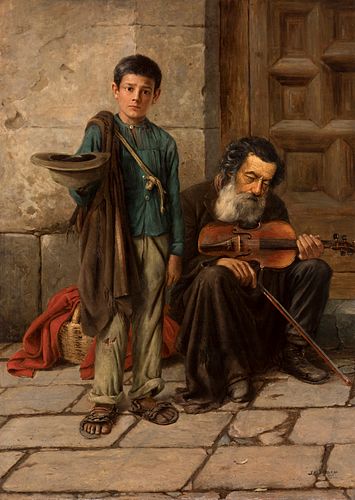JOSEPH KLEITSCH (Hungary, 1882-United States, 1931). "The blind and beggar", 1908. Oil on canvas.
Lot 87
About Seller
Setdart Auction House
Carrer Aragó 346
Barcelona
Spain
Setdart Subastas was born in 2004 and is currently the first online art auction in Spain with solidity, prestige and reliability guaranteed by our more than 60,000 users. Setdart has a young, dynamic and enterprising team ready to successfully manage the purchase and sale of art works through custom...Read more
Estimate:
EUR€60,000 - EUR€70,000
$64,516.13 - $75,268.82
Absentee vs Live bid
Two ways to bid:
- Leave a max absentee bid and the platform will bid on your behalf up to your maximum bid during the live auction.
- Bid live during the auction and your bids will be submitted real-time to the auctioneer.
Bid Increments
| Price | Bid Increment |
|---|---|
| EUR€0 | EUR€10 |
| EUR€200 | EUR€25 |
| EUR€500 | EUR€50 |
| EUR€1,000 | EUR€100 |
| EUR€3,000 | EUR€200 |
| EUR€5,000 | EUR€500 |
| EUR€10,000 | EUR€1,000 |
| EUR€20,000 | EUR€2,000 |
| EUR€50,000 | EUR€5,000 |
About Auction
By Setdart Auction House
Nov 10, 2021
Set Reminder
2021-11-10 08:00:00
2021-11-10 08:00:00
America/New_York
Bidsquare
Bidsquare : 19th & 20th Century paintings and Decorative Arts
https://www.bidsquare.com/auctions/setdart-auction-house/19th-20th-century-paintings-and-decorative-arts-7800
Setdart Auction House sofia@setdart.com
Setdart Auction House sofia@setdart.com
- Lot Description
JOSEPH KLEITSCH (Hungary, 1882-United States, 1931). "The blind and beggar", 1908. Oil on canvas. Attached certificate issued by Redan Hughes. Presents faults and restorations in the frame. Signed, dated and located (Mexico), in the lower right corner. Measurements: 150 x 105.5 cm; 176 x 136 cm (frame). Starring a young lazarillo and an elderly beggar, this work captures the viewer's attention through a realistic language that uses a stark scene, which specifies poverty, and the disadvantaged situation of both characters, a child and an old man, who are on the margins of the working population, thus being the most vulnerable to poverty. Both the subject matter and the technical style of the work are aesthetically close to the aesthetic characteristics in vogue during the 19th century in the United States. This was a place where an artistic tradition linked to portraiture had developed. In addition, the progress of the industrial revolution provoked the birth of new social classes, the definition of these, and a social situation of injustice and generalized poverty. This atmosphere was picked up by different artists, who used their art as an instrument of social criticism. An example of this was the literature of Mark Twain, or the art of some of the painters who from 1830 onwards embraced the representation of the genre scene, motivated above all by the growing illustration, newspapers and magazines, which accustomed the public to scenes of everyday life. Of Hungarian origin, Joseph Kleitsch, was born in a region now belonging to Romania. His interest in art began at an early age, as he started painting at the age of seven. He later pursued his artistic training in Budapest, Munich and Paris. In 1912, Kleitsch emigrated to the United States, settling in the city of Chicago. Influenced by his visits to the famous museums of Europe, Kleitsch developed a taste for portraiture and figurative painting, which earned him the recognition of high society. Upon moving to California, his works underwent an aesthetic shift, in which the painter became interested in capturing the bright light and diverse landscape of his new surroundings. In 1920, Kleitsch settled permanently in the artists' village of Laguna Beach, becoming an important resident of the Laguna Beach Artists Colony, where he opened his own gallery. Arthur Millier, a Los Angeles Times commentator, wrote of Kleitsch: "He was a born colorist; he seemed to play on canvas with the abandon of a gypsy violinist." Today his works are part of important collections, both private and public, highlighting art spaces such as; Joseph Kleitsch Fine Art, Beverly Hills, Irvine Museum, in California, Crocker Art Museum in Sacramento, California, Pasadena Museum of California Art, in California, and Fleischer Museum, in Scottsdale, Arizona, among many others.
- Shipping Info
-
In-house shipping available. Please inquire at admin@setdart.com.
-
- Buyer's Premium



 EUR
EUR CAD
CAD AUD
AUD GBP
GBP MXN
MXN HKD
HKD CNY
CNY MYR
MYR SEK
SEK SGD
SGD CHF
CHF THB
THB


















